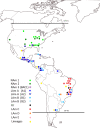Considerations about the Geographic Distribution of Histoplasma Species
- PMID: 35262368
- PMCID: PMC9004366
- DOI: 10.1128/aem.02010-21
Considerations about the Geographic Distribution of Histoplasma Species
Abstract
Histoplasmosis is a mycotic infection principally affecting pulmonary tissue; sometimes, histoplasmosis can progress into a systemic disease. This infection involves immunocompetent and immunosuppressed human and other mammalian hosts, depending on particular circumstances. Histoplasmosis infection has been documented worldwide. The infection is acquired by inhaling infective mycelial propagules of the dimorphic fungus Histoplasma capsulatum. New reports of clinical cases of histoplasmosis in extreme latitudes could be related to human social adaptations and climate changes in the world, which are creating new favorable environments for this fungus and for bats, its major natural reservoirs and dispersers. Histoplasma has been isolated from most continents, and it is considered a complex of cryptic species, consisting of various groups of isolates that differ genetically and correlate with a particular geographic distribution. Based on updated studies, Histoplasma taxonomy is adjusting to new genetic data. Here, we have suggested that Histoplasma has at least 14 phylogenetic species distributed worldwide and new genotypes that could be under deliberation. Histoplasma's geographic radiation began in South America millions of years ago when the continents were joined and the climate was favorable. For fungal spreading, the role of bats and some birds is crucial, although other natural factors could also participate.
Keywords: Histoplasma capsulatum; Histoplasma spp.; bats; climate changes; spreading; worldwide distribution.
Conflict of interest statement
The authors declare no conflict of interest.
Figures


References
Publication types
MeSH terms
LinkOut - more resources
Full Text Sources
Medical
Miscellaneous

